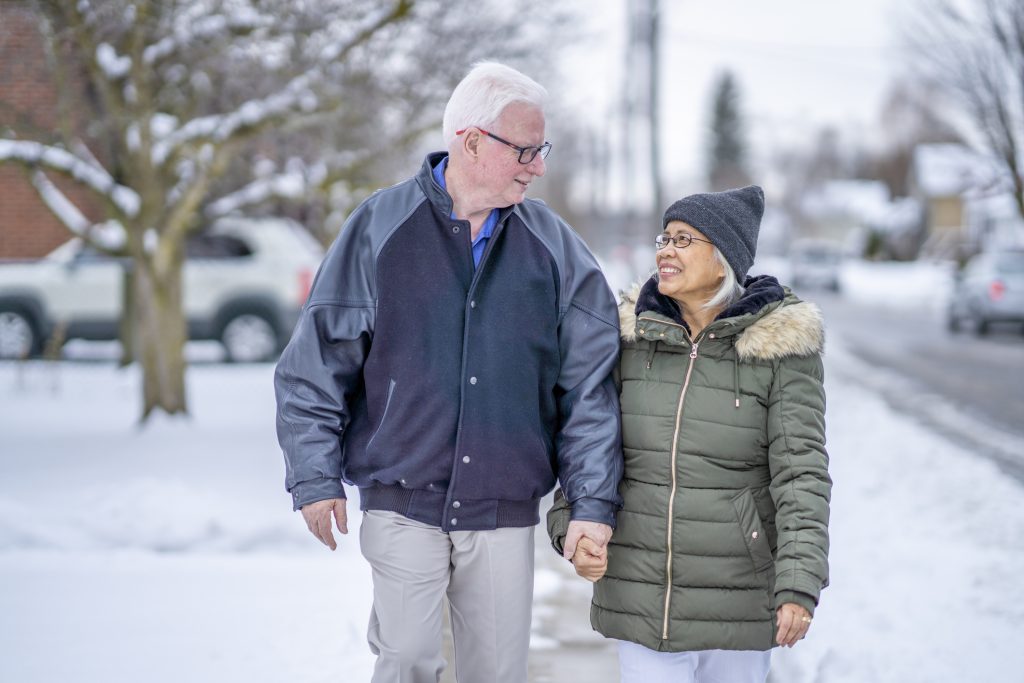




Walking is the most popular form of exercise in the U.S. and is a great low-impact, aerobic activity, especially for elderly adults. Experts recommend adults aged 65 and older spend at least 150 minutes a week engaged in moderate aerobic exercise, such as brisk walking, to enhance well-being. There are many benefits of walking such as improving heart health, lowering blood sugar, boosting mood, supporting joints, and even lowering the risk of dementia.
Walking not only improves overall health but also helps seniors preserve their physical and cognitive independence!
It’s important to take precautions to keep yourself and your loved ones safe while walking outside to avoid falls and injuries, especially in the winter months. Consider the following for your next walk:
Don’t let the need for a mobility aid keep you or your loved ones from going on a walk. Mobility aids provide support, improve safety, and extend independence. There is a wide range of aids available to best fit your individual needs so you can feel more confident taking walks:
Canes are helpful for people who have minor balancing issues or have one side that is slightly weaker. Single-tip canes only lend extra support to one side of your body and do not provide full body support. Quad-tip canes provide extra stability and support and may be better suited for rougher terrain than single-tip canes. Glow-in-the dark cane tips are available for enhanced safety in low-light conditions.
Walkers are useful aids for people needing a little help with balance and mobility but still have good upper and lower body strength. They are also useful for traversing flat surfaces that are too rough for wheels, such as grass or cobblestone pathways.
Rollators are similar to walkers but they have four wheels and don’t need to be lifted to maneuver. Rollators allow users to walk at a quick pace, feature brakes, and have a built-in seat to allow for rests. They are suitable for flat surfaces like tile or pavement.
If you or your loved one is unable to walk or requires a wheelchair for different reasons, it’s still important to get outside. Being outside exposes you to vitamin D, which 75% of adults lack. Fresh air can also help boost the immune system, increase energy levels, strengthen lung function, and even lower blood pressure and heart rate.
Homecare Hospital Beds offers an array of affordable mobility aids.
Shop the full product line here.
Walking can be a great way to get active, change up your routine, and get some fresh air. Whether walking alone, with a friend, or in a group, always be cautious, alert, and use your mobility aid for added safety and confidence. Be sure to talk to your healthcare provider before introducing walking into your daily routine.




| Cookie | Duration | Description |
|---|---|---|
| cookielawinfo-checkbox-analytics | 11 months | This cookie is set by GDPR Cookie Consent plugin. The cookie is used to store the user consent for the cookies in the category "Analytics". |
| cookielawinfo-checkbox-functional | 11 months | The cookie is set by GDPR cookie consent to record the user consent for the cookies in the category "Functional". |
| cookielawinfo-checkbox-necessary | 11 months | This cookie is set by GDPR Cookie Consent plugin. The cookies is used to store the user consent for the cookies in the category "Necessary". |
| cookielawinfo-checkbox-others | 11 months | This cookie is set by GDPR Cookie Consent plugin. The cookie is used to store the user consent for the cookies in the category "Other. |
| cookielawinfo-checkbox-performance | 11 months | This cookie is set by GDPR Cookie Consent plugin. The cookie is used to store the user consent for the cookies in the category "Performance". |
| viewed_cookie_policy | 11 months | The cookie is set by the GDPR Cookie Consent plugin and is used to store whether or not user has consented to the use of cookies. It does not store any personal data. |